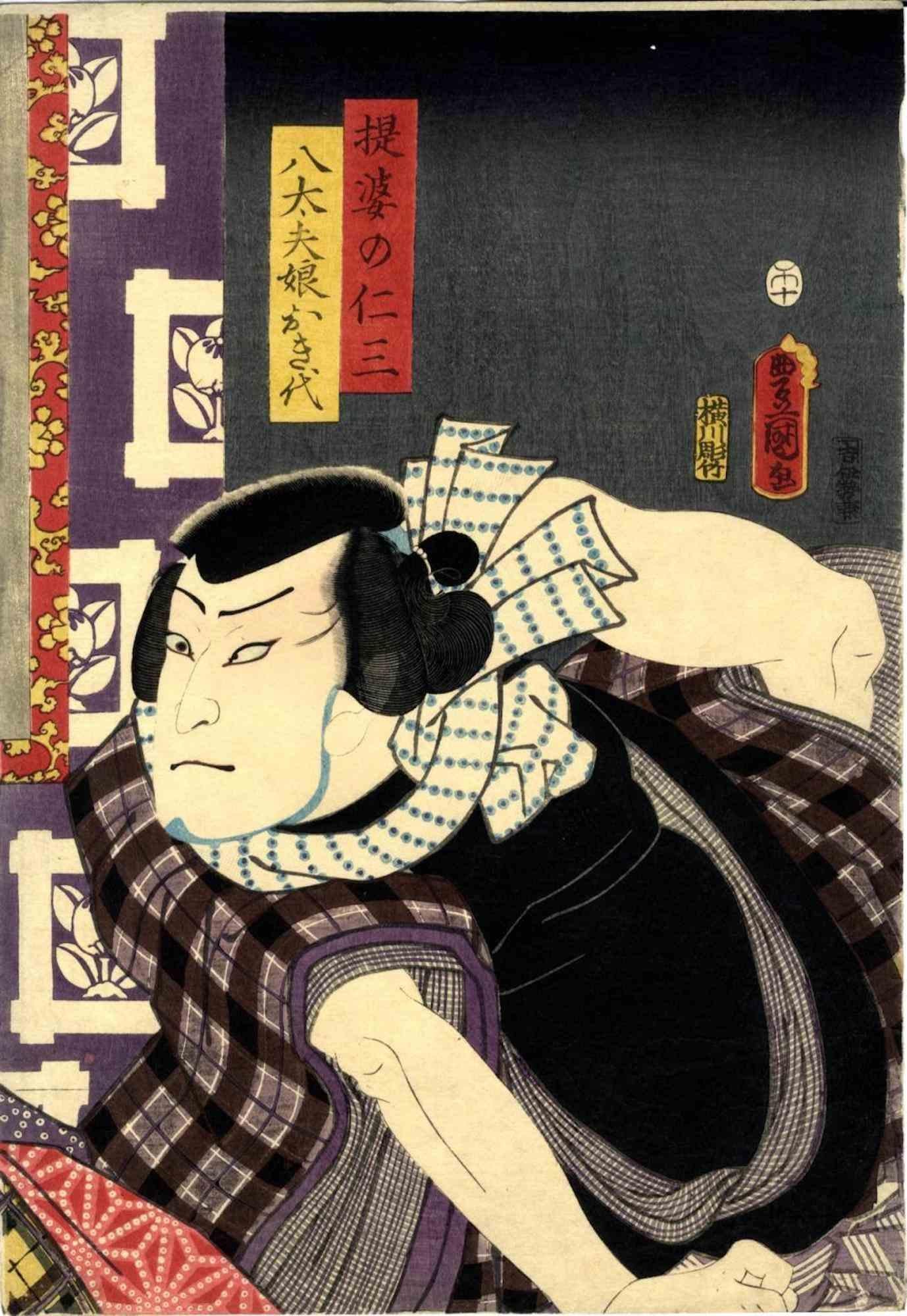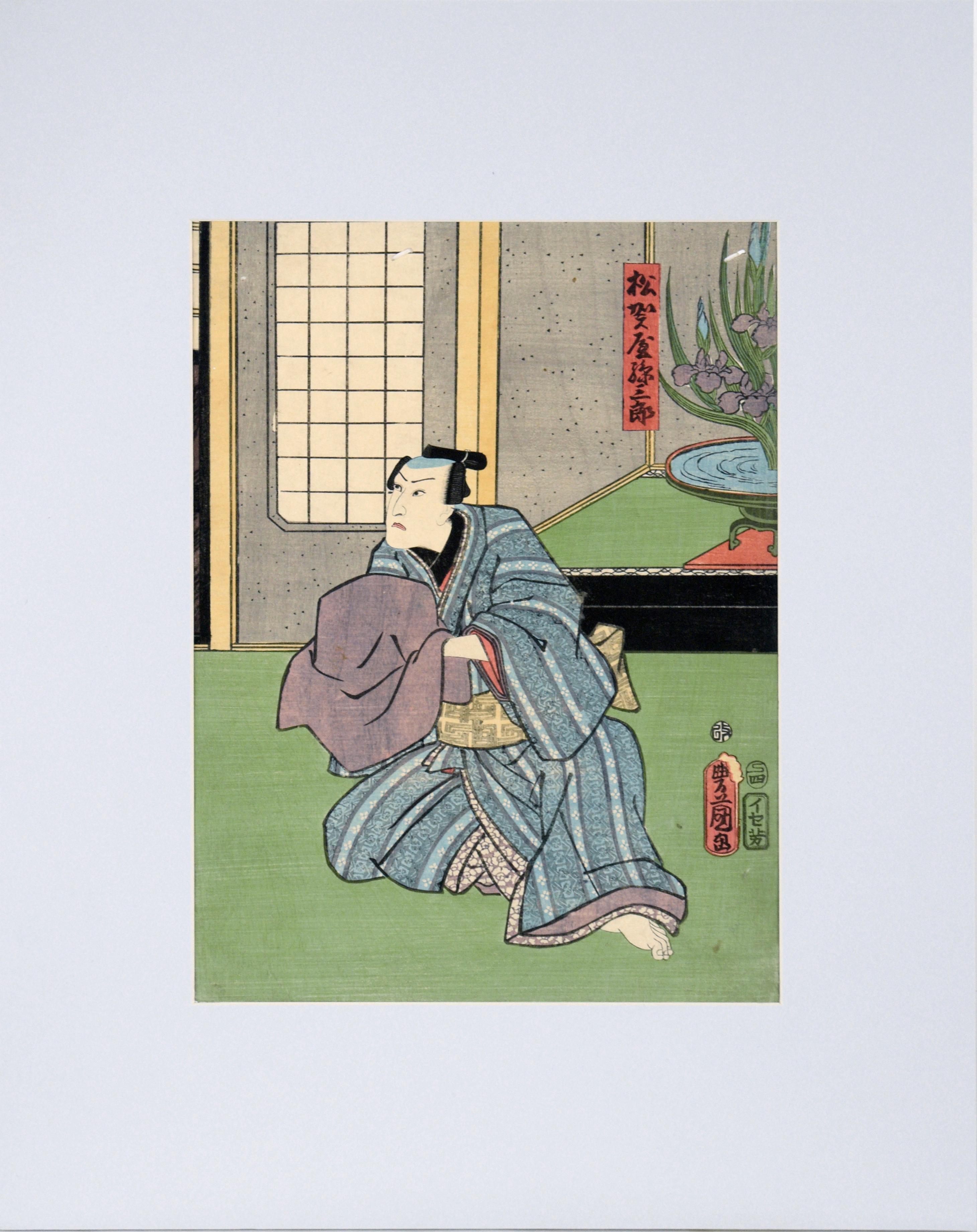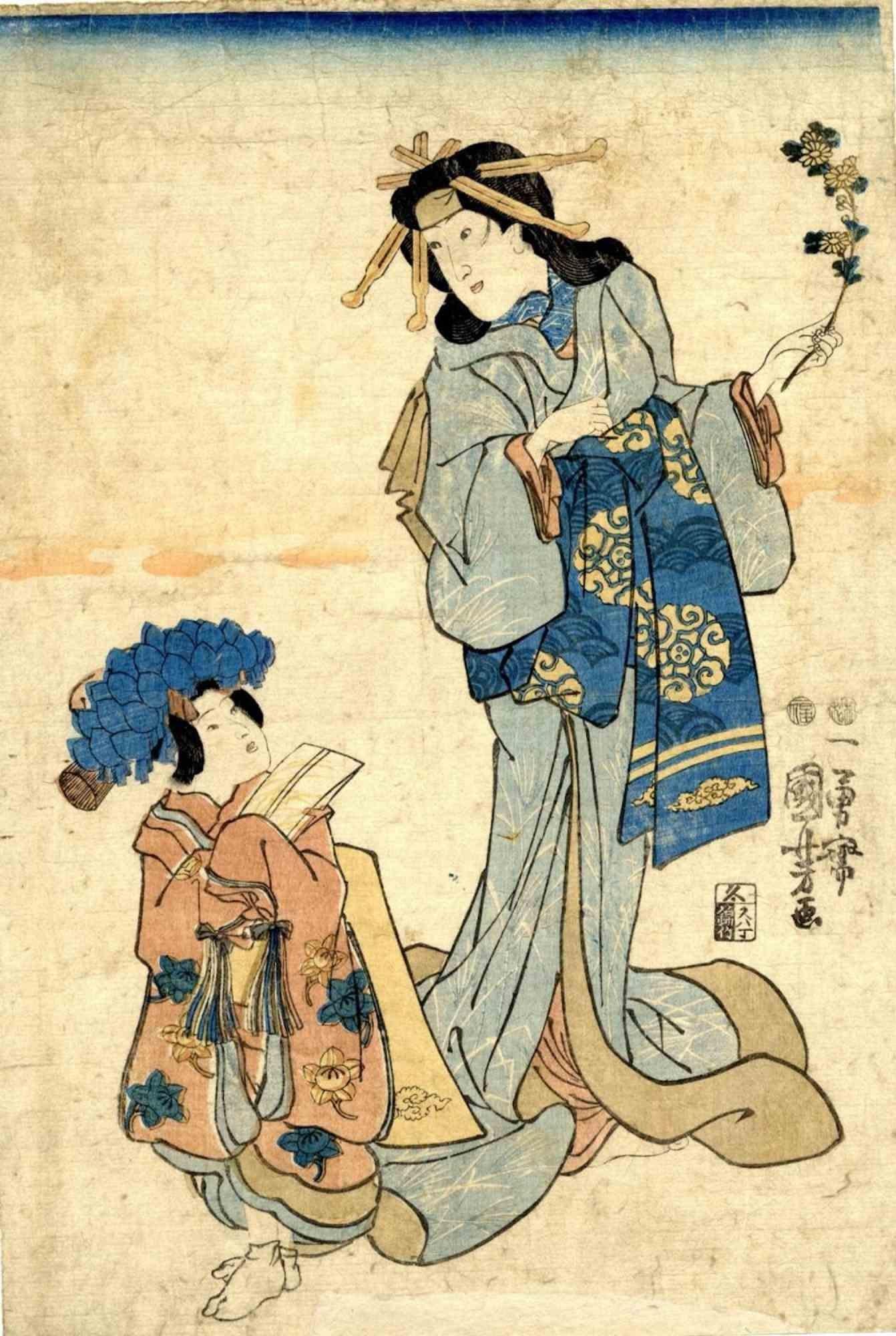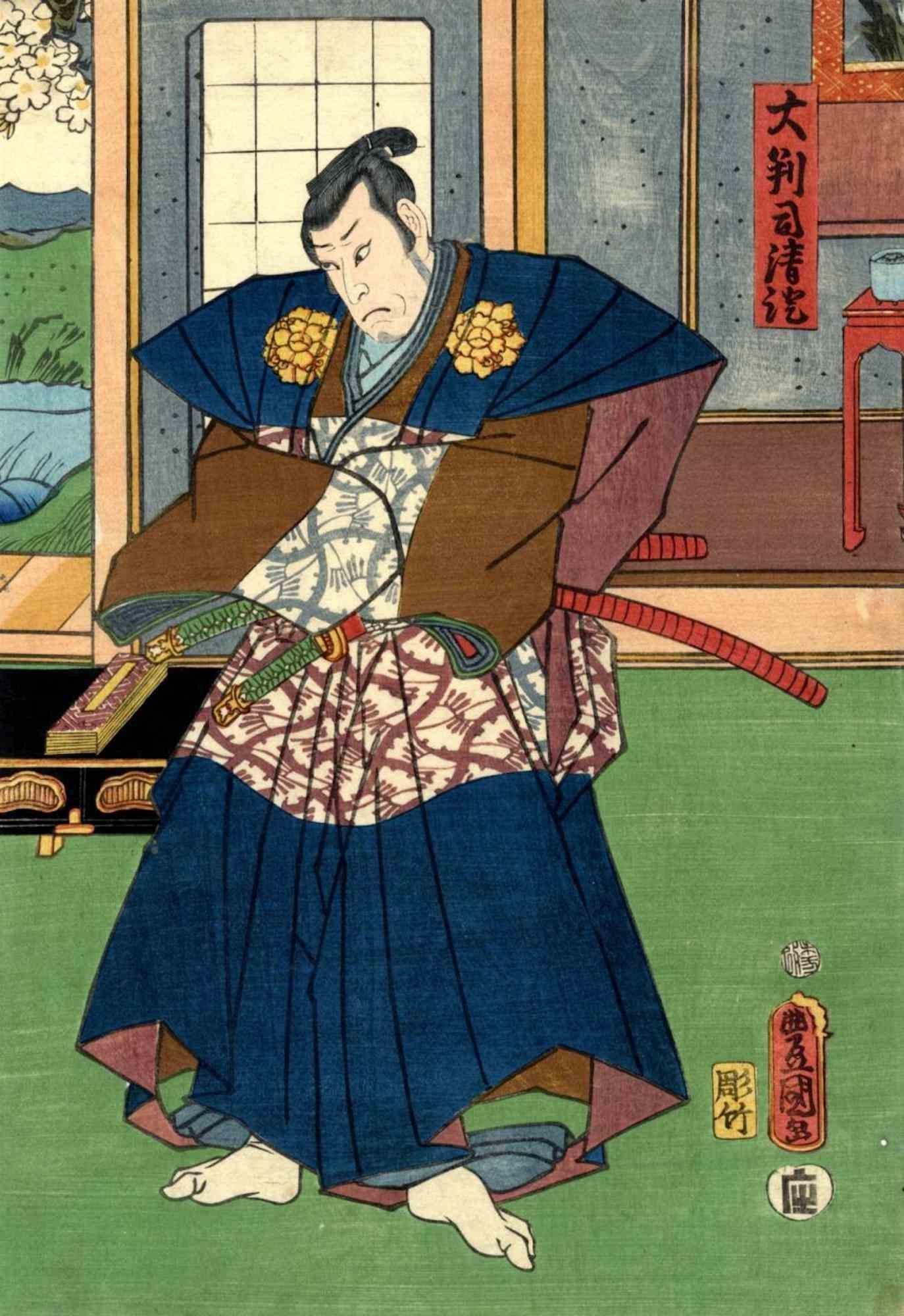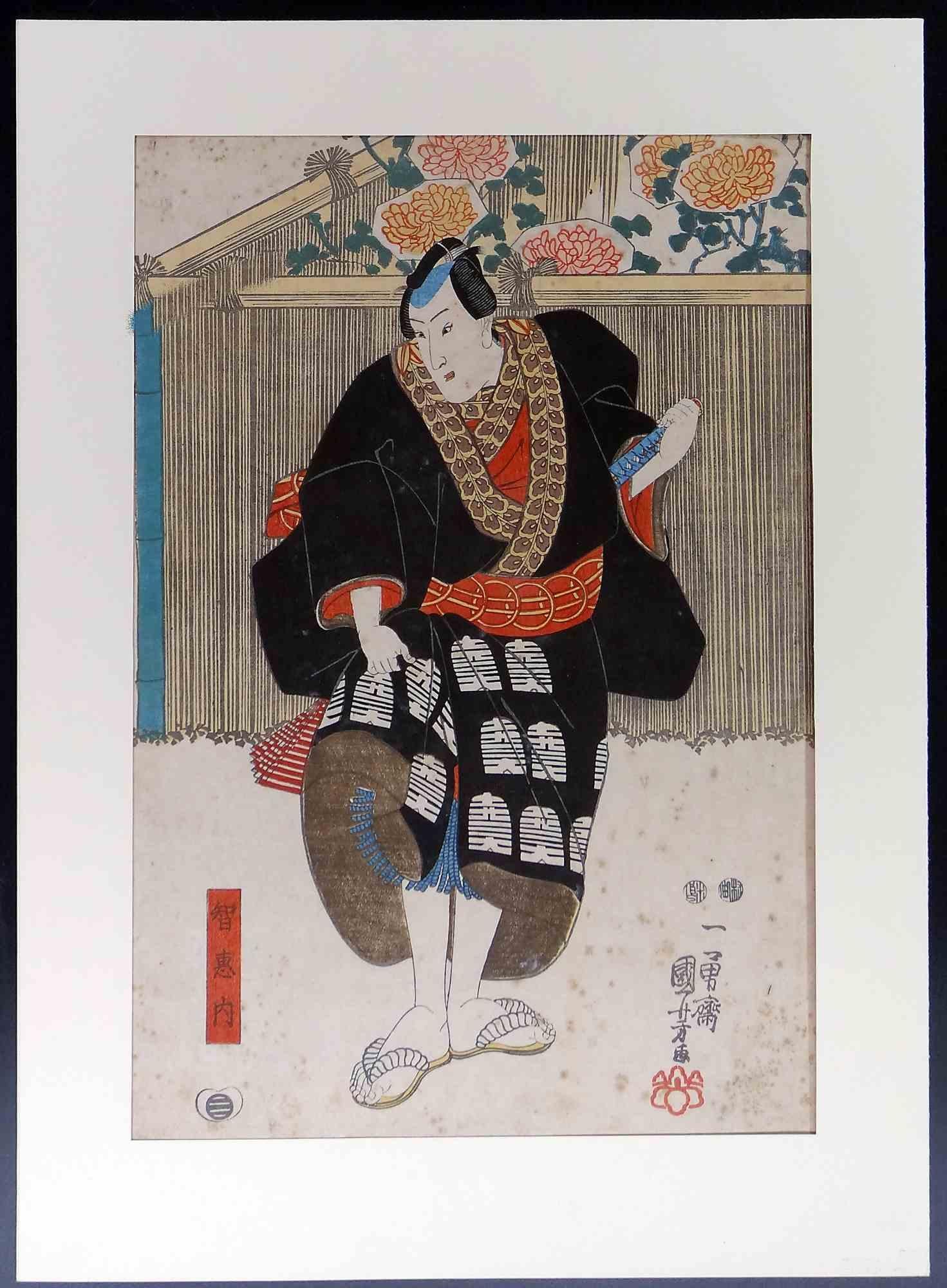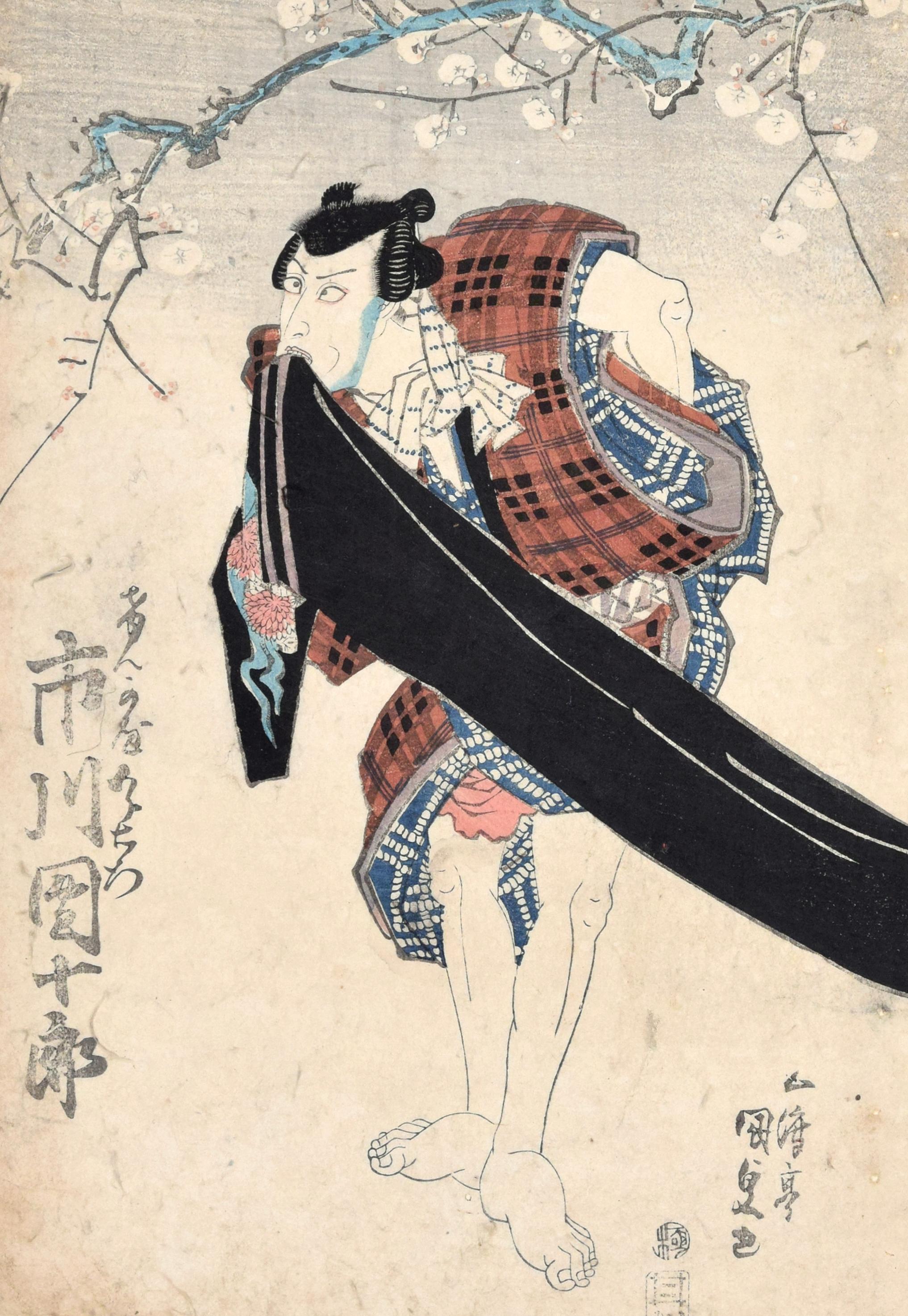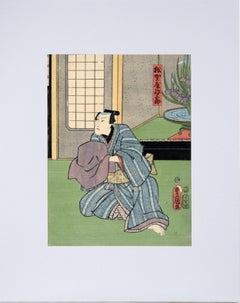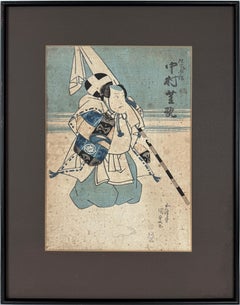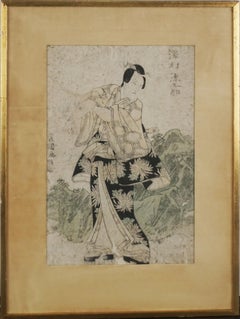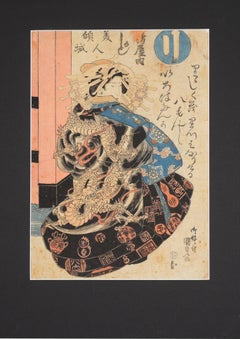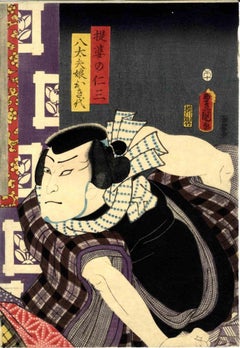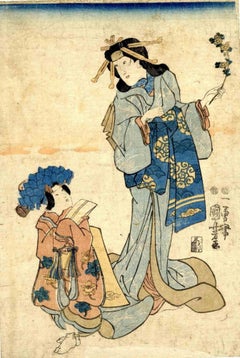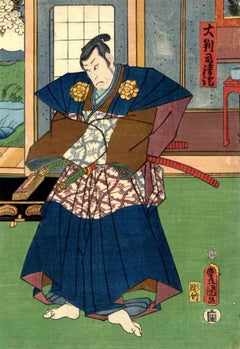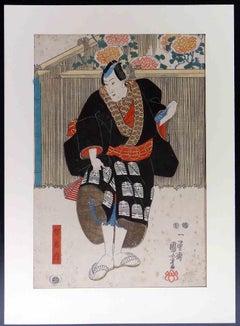Items Similar to "Candy Seller" Japanese Woodblock on Rice Paper
Want more images or videos?
Request additional images or videos from the seller
1 of 11
Utagawa Yoshiiku"Candy Seller" Japanese Woodblock on Rice Paper1861
1861
$617.50
$95035% Off
£464.49
£714.6035% Off
€535.40
€823.7035% Off
CA$869.82
CA$1,338.1835% Off
A$954.40
A$1,468.3035% Off
CHF 499.49
CHF 768.4435% Off
MX$11,745.39
MX$18,069.8335% Off
NOK 6,292.78
NOK 9,681.2135% Off
SEK 5,894.13
SEK 9,067.8935% Off
DKK 3,997.79
DKK 6,150.4435% Off
About the Item
"Candy Seller" (飴売りうずまつ 市村羽左衛門) Japanese Woodblock on Rice Paper
This piece depicts Ichimura Uzaemon as the Candy Peddler Uzumatsu. He is playing a stringed instrument (the shamisen) to attract people to come buy canbdy. The spiral on his clothing is the symbol of the candy seller, along with his crest of the mandarin orange.
This Utagawa Yoshiiku print, titled "Umegoyomi mitate hachi shojin" (梅暦見立八笑人), depicts a scene from the Edo period. The print features a prominent male figure playing a shamisen, a traditional Japanese stringed instrument. The text on the print is in Japanese, and the overall style is characteristic of Ukiyo-e, a genre of Japanese woodblock prints. Utagawa Yoshiiku was a significant artist of the Meiji era, known for his contributions to woodblock printmaking. He was a student of Utagawa Kuniyoshi and worked alongside Tsukioka Yoshitoshi. His works often portray historical events, scenes from Kabuki plays, and contemporary life. This print, in particular, showcases the artist's skill in capturing the details of clothing, facial expressions, and the musical instrument.
Presented in a new blue mat with foam core backing.
Mat size: 18"H x 14"W
Paper size: 16"H x 12"W
Born the son of teahouse proprietor Asakusa Tamichi in 1833, Utagawa Yoshiiku (also known as Ochiai Yoshiiku) became a student of ukiyo-e artist Utagawa Kuniyoshi toward the end of the 1840s. His earliest known work dates to 1852 when he provided the backgrounds to some actor prints by his master.
Yoshiiku's earliest works were portraits of actors (yakusha-e), beauties (bijin-ga), and warriors (musha-e). He later followed Kuniyoshi into making satirical and humorous pieces, and became the leading name in the field after Kuniyosh's death in 1861. He illustrated the Tokyo Nichi Nichi Shimbun ("Tokyo Daily News") from 1874 to 1876, and then co-founded the Tokyo E-iri Shinbun ("Tokyo Illustrated News"). The latter folded in 1889, and Yoshiiku returned to making prints. He struggled during his last years, and his last known print appeared in 1903. His three known students, Ikumura, Ikuei, and Ikumasa, failed to achieve recognition.
Yoshiiku had ten children with his second wife, only one of whom survived childhood. Yoshiiku died at age 71 in a temporary residence on 6 February 1904 in Honjo. He was buried at Anseiji temple in Asakusa and given the posthumous Buddhist name Juzen'in Hōkinikkaku Koji.
(Biography from Wikipedia)
- Creator:Utagawa Yoshiiku (1833 - 1904)
- Creation Year:1861
- Dimensions:Height: 18 in (45.72 cm)Width: 14 in (35.56 cm)Depth: 0.25 in (6.35 mm)
- Medium:
- Movement & Style:
- Period:
- Condition:Some yellowing to paper, as expected. Small punctures in upper right corner.
- Gallery Location:Soquel, CA
- Reference Number:Seller: DBH98671stDibs: LU54216434542
About the Seller
5.0
Platinum Seller
Premium sellers with a 4.7+ rating and 24-hour response times
Established in 1986
1stDibs seller since 2014
2,991 sales on 1stDibs
Typical response time: <1 hour
- ShippingRetrieving quote...Shipping from: Soquel, CA
- Return Policy
Authenticity Guarantee
In the unlikely event there’s an issue with an item’s authenticity, contact us within 1 year for a full refund. DetailsMoney-Back Guarantee
If your item is not as described, is damaged in transit, or does not arrive, contact us within 7 days for a full refund. Details24-Hour Cancellation
You have a 24-hour grace period in which to reconsider your purchase, with no questions asked.Vetted Professional Sellers
Our world-class sellers must adhere to strict standards for service and quality, maintaining the integrity of our listings.Price-Match Guarantee
If you find that a seller listed the same item for a lower price elsewhere, we’ll match it.Trusted Global Delivery
Our best-in-class carrier network provides specialized shipping options worldwide, including custom delivery.More From This Seller
View All"Sun Saburo Matsugaya" - Mid 19th Century Figurative Japanese Woodblock Print
By Utagawa Kunisada (Toyokuni III)
Located in Soquel, CA
"Sun Saburo Matsugaya" - Mid 19th Century Figurative Japanese Woodblock Print
Beautiful mid 19th century figural Japanese woodblock print of a seated man with lilies in the background by Utagawa Toyokuni III (Kunisada) (Japanese, 1786-1864/5). Artist's chop is in the lower right corner of the piece. The actor is Magosaburo Matsugaya from the play "Katakiuchi Rumors"
Presented in a new grey-blue mat with foamcore backing.
Mat size: 21"H x 16"W
Paper size: 14"H x 9.75"W
During his lifetime Kunisada Utagawa...
Category
1850s Edo Figurative Prints
Materials
Paper, Ink, Woodcut
Kabuki actor Nakamura Shikan II by Utagawa Kunisada Edo Japanese Woodblock Print
By Utagawa Kunisada (Toyokuni III)
Located in Soquel, CA
Kabuki actor Nakamura Shikan II by Utagawa Kunisada Japanese Woodblock Print
Wonderful portrait of Nakamura Shikan II, a prominent kabuki actor, in the role of Kisen Hoshi Toyokuni ...
Category
1820s Realist Figurative Prints
Materials
Printer's Ink, Rice Paper, Woodcut
Kabuki Actor in Water Lily Robe with Samurai Sword - Japanese Woodblock Print
By Utagawa Toyokuni
Located in Soquel, CA
Kabuki Actor in Water Lily Robe with Samurai Sword- Japanese Woodblock Print
Finely detailed woodblock by Utagawa Toyokuni (Japanese, 1769-1825). A kabuki actor ("Master Haranyuki Sawamura") is standing on stage with mountainous backdrop, wearing a robe in a water lily pattern. He is wearing a samurai sword.
Presented in a gold colored frame with a silk mat.
Frame size: 20"H x 14.25"W
Image size: 14"H x 9"W
Utagawa Toyokuni (Japanese, 1769-1825) was born in Edo, the son of Kurahashi Gorobei, a carver of dolls and puppets...
Category
Early 19th Century Edo Figurative Prints
Materials
Ink, Rice Paper, Woodcut
The Courtesan Kashiwagi and the Kamuro Wakano - Japanese Woodblock Print
By Utagawa Kunisada (Toyokuni III)
Located in Soquel, CA
The Courtesan Kashiwagi and the Kamuro Wakano - Japanese Woodblock Print
Original Toyokuni III/Kunisada (Japanese, 1786 - 1864) Japanese Woodblock Print
"The Courtesan Kashiwagi and...
Category
1820s Realist Figurative Prints
Materials
Printer's Ink, Rice Paper, Woodcut
Kabuki Actor, Mid 19th Century Figurative Japanese Woodblock Print
By Utagawa Kunisada (Toyokuni III)
Located in Soquel, CA
Beautiful mid 19th century figural Japanese woodblock print of a kabuki actor in blue by Utagawa Toyokuni III (Kunisada) (Japanese, 1786-1864/5). Artist's chop is in the upper left corner of the piece. Presented in a cream mat, with a black and red frame and plexiglas. Image size ~13.5"H x 9.5"W
During his lifetime Kunisada Utagawa...
Category
1860s Edo Figurative Prints
Materials
Paper, Ink
"Thirsty: the appearance of a town geisha in the Ansei era" - Woodblock on Paper
By Tsukioka Yoshitoshi
Located in Soquel, CA
"Thirsty: the appearance of a town geisha in the Ansei era" - Woodblock on Paper
From the series "Thirty-two Aspects of Customs and Manners" (Fuzoku sanjuniso)
Lively woodblock of a...
Category
1880s Edo Figurative Prints
Materials
Paper, Ink, Woodcut
You May Also Like
Portrait of Nakamura Fukus - Woodcut Print by Utagawa Kunisada - 1850s
By Utagawa Kunisada (Toyokuni III)
Located in Roma, IT
Portrait of the actor Nakamura Fukusuke I is an original modern artwork realized by Utagawa Kunisada in 1858.
Woodcut print Oban Format from a tryptich.
Portrait of the actor Nakam...
Category
19th Century Modern Figurative Prints
Materials
Woodcut
Actor in Onnagata Role - Woodcut Print by Utagawa Kuniyoshi - 1850s
By Utagawa Kuniyoshi
Located in Roma, IT
Actor in onnagata role accompanied by a kamuro is an original artwork realized in the 1850s by Utagawa Kuniyoshi (January 1, 1798– April 14, 1861).
Woodcut Print.
Sign.: Ichiyusai ...
Category
1850s Modern Figurative Prints
Materials
Woodcut
Judge Dai Hanji Kiyozumi - Woodcut Print by Utagawa Kunisada - 1859
By Utagawa Kunisada (Toyokuni III)
Located in Roma, IT
Judge Dai Hanji Kiyozumi is an original modern artwork realized by Utagawa Kunisada in 1859.
Woodcut Print Oban Format, from a triptych, 1859.
Actor in the role of Judge Dai Hanji ...
Category
19th Century Modern Figurative Prints
Materials
Woodcut
Theater Actor in Black Coat on Stage- Woodcut by Utagawa Kunisada - 19th Century
By Utagawa Kunisada III
Located in Roma, IT
This figuration of a theater actor in a black coat on stage is the work of the Japanese artist Utagawa Kuniyoshi /1798-1861).
The brilliance of the colors, the graphic precision as ...
Category
19th Century Old Masters Figurative Prints
Materials
Woodcut
Kabuki Actor - Original Woodcut by Utagawa Kunisada - 1830 ca.
By Utagawa Kunisada (Toyokuni III)
Located in Roma, IT
Kabuki actor is a superb colored woodblock print realized around 1830 by one of the most famous Japanese Ukiyo-e artists Utagawa Kunisada, also known as Utagawa Toyokuni III (1786 - ...
Category
1830s Modern Figurative Prints
Materials
Woodcut
Man in Blue Coat Carrying Goods - Woodcut by Utagawa Kunisada - 19th Century
By Utagawa Kunisada III
Located in Roma, IT
This portrait of a man in Blue Coat carrying goods in the work of the japanese artist Utagawa Kunisada (1786-1865), otherwise known as Toyokuni III.
Whether through the use of color...
Category
19th Century Old Masters Figurative Prints
Materials
Woodcut
More Ways To Browse
Japan Antique Paper
Woodblock Japan
Japanese Seller
Antique Candy
Japanese Warrior
Meiji Woodblock
Used String Instruments
Antique String Instrument
Nichi Nichi
Warhol Trial Proof
1970s Printed Mirror
Al Pounders
Alberto Giacometti On Sale
Allison Lefcort On Sale
American Psycho
Ayako Rokkaku
Bassano Plates
Basya Wuensch Reiter
